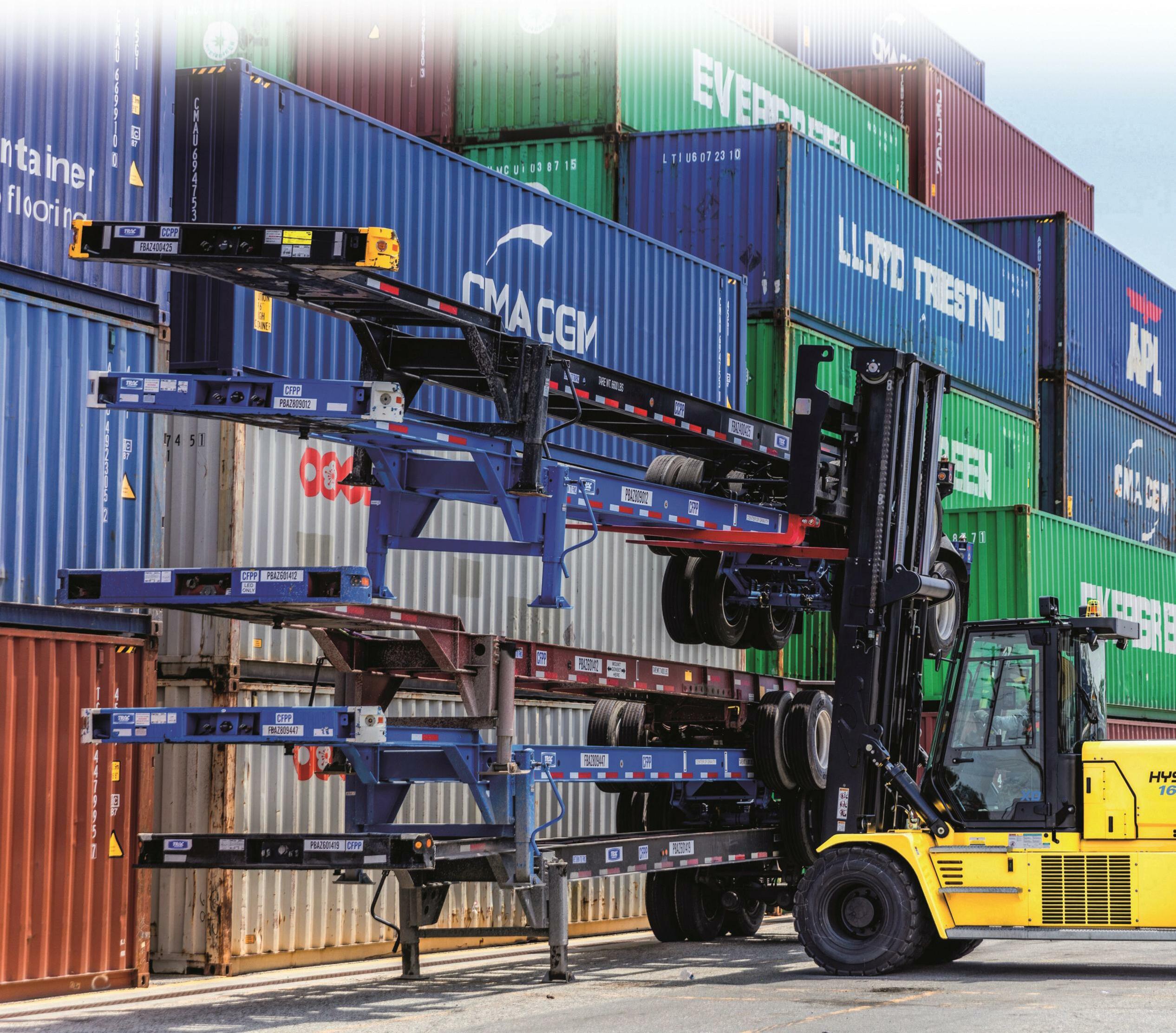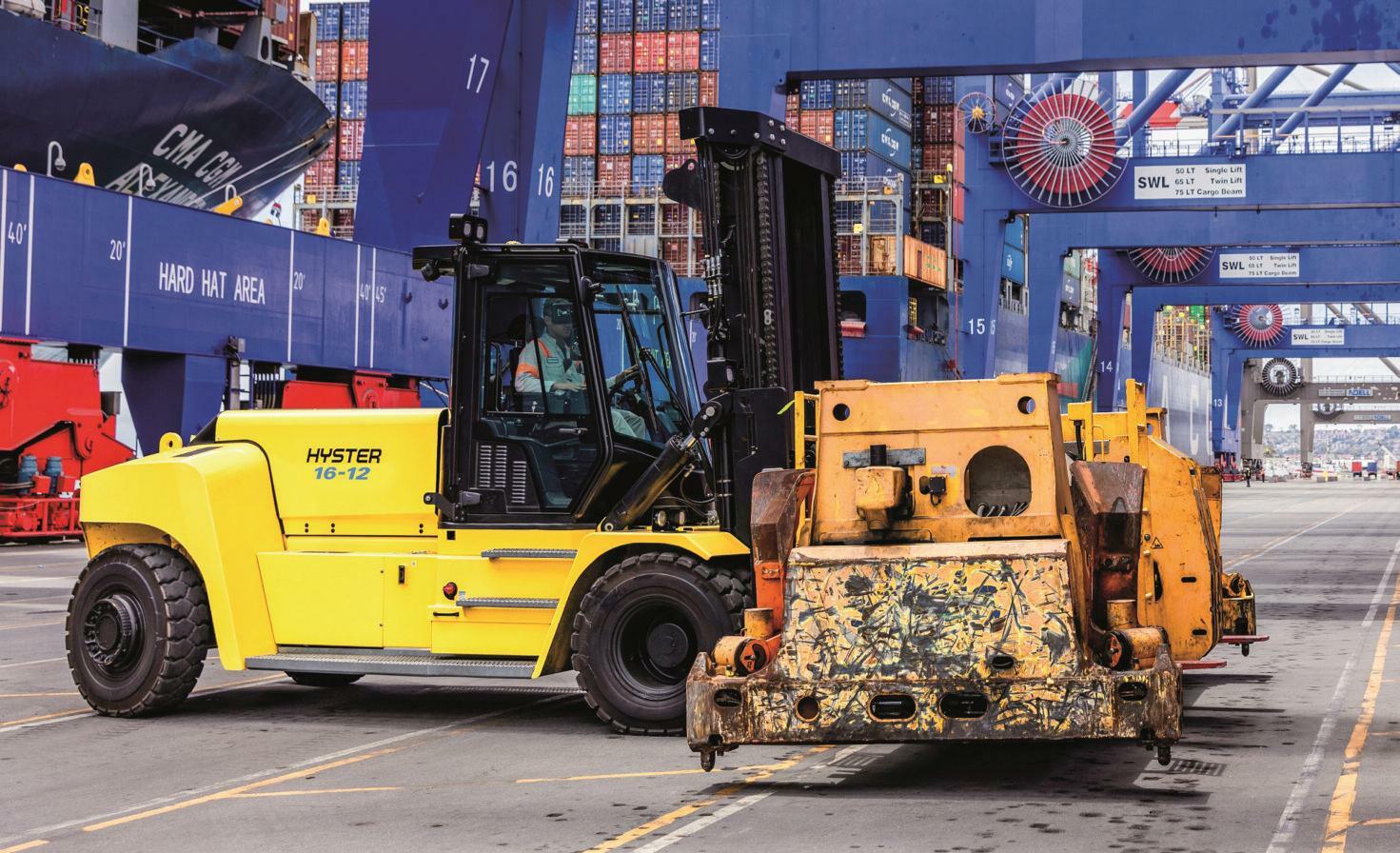
6 minute read
Bringing big trucks into the electric age

B Br ri in ng gi in ng g b bi ig g t tr ru uc ck ks s i in nt to o t th he e e el le ec ct tr ri ic c a ag ge e
JanWillemvandenBrand,Director GlobalMarketDevelopmentBigTrucks forHyster,looksattheoptionsfor terminaloperatorstogoelectric…
G
reen-focused targets have been embraced by governments worldwide, such as the US government aiming to cut greenhouse gas emissions in half from 2005 levels by 2030, and the European Union setting rules to achieve at least 32% renewable energy by the same deadline. These bold targets impact port terminal operations worldwide, particularly because supply chains are an important focus area according to the CDP (Carbon Disclosure Project), supply chains often account for more than 90% of an organisation ’ s GHG emissions.
For ports to fulfil their part in meeting emissions reduction goals, they need the right power technology and the infrastructure to support it. Luckily, for intensive operations such as ports, the number of suitable electric options for forklifts and material handling equipment continues to grow.

However, before deciding whether to electrify, it’ s important to consider what options are available and which considerations are priorities for the operation.
Going electric without compromising operational requirements
Leaving behind internal combustion engine (ICE) power in favour of electrification does not mean sacrificing productivity. Electric power can deliver the performance you expect from a diesel, with charging capability to work effectively in heavy duty applications. Electric drivetrains also have fewer components and less complexity than ICE, offering similar or better reliability with reduced maintenance.
Electric options can also help reduce costs related to fuel consumption and engine maintenance. Currently there are incentives, grants, and offset credit programmes, such as the Diesel Emissions Reduction Act (DERA) programme in the US and various tax subsidies in many European countries that make the business case even more attractive. Governments and businesses are embracing electrification as a means to reduce emissions and are investing in the infrastructure necessary to support it.
Of course, electric lift trucks may not make sense for every port or terminal operation. Not only must operations find an electric solution with the necessary performance to get the job done, factors like local utility grid capacity and run time requirements come into play. For example, more developed areas with weak electric grids can experience brownouts that slow down operations and time spent charging equipment must not compromise operational schedules.
What are the electrification options for port applications?
High-capacity applications in port terminals have long relied on the exceptional durability and consistent power delivery of internal combustion engines. But now lithium-ion batteries provide an electric option capable of delivering the diesel-like performance terminal operations require - a major step forward from lead-acid batteries.
This capability is possible because lithium-ion batteries can tolerate a high energy draw without overheating or dropping in efficiency. Lithium-ion technology also provides far greater energy density, power transfer and service life than lead-acid batteries. Lithium-ion batteries are powering lift trucks of increasingly high capacity. For example, Hyster recently introduced the J10-18XD lift truck with factory integrated lithium-ion power, for lifts up to 18-tonnes.With 350-volt lithium-ion batteries, these trucks will still be going strong when 120-volt lead-acid batteries are done for the day.
Equipment powered by hydrogen fuel cells, such as those from Nuvera, may also be an option.These solutions combine the simplicity and sustained performance of internal combustion engines with the zero harmful emissions and maintenance-friendly attributes of electric technologies.An added benefit is the speed with which they can be refuelled as quickly as three minutes, with no downtime for battery changing and charging, and no need to remember to plug in during breaks to opportunity charge
As well as providing opportunities to electrify forklifts, electrification is taking on even higher capacity equipment, with hydrogen fuel cell and lithium-ion battery powered solutions in development for container handlers and reachstackers used in port settings.For instance, equipment with a large lithium-ion battery that offers choice between conventional and opportunity charging, designed for a medium-duty cycle. Or container handlers with a hydrogen fuel cell working in combination with lithium-ion battery, offering a choice between conventional and opportunity charging, and standing up to a heavy-duty cycle - enabling operators to work a full day without refilling. Matching performance to operational requirements in this way can expand the possibilities for electric power adoption and help enable further progress toward emissions reduction.
What does electric mean for ergonomics?
Of course, emissions reduction and strong, sustained performance are not the only benefits for intense applications exploring electrification. Many operations are struggling to recruit, train, and retain sufficient labour. In fact, according to the MHI Annual Industry Report in the US, respondents continue to identify hiring and retaining talent as their greatest challenge, with a majority rating it as extremely or very challenging.And with demanding duty cycles and inhospitable environments pushing both equipment and operators to their limits, businesses need to find equipment tough enough to depend on, with the ergonomics to help operators perform at their best.
Ergonomic, electric equipment can be part of the answer to maximising the efficiency and productivity of operators and their time. Reduced charging or refuelling time, fewer maintenance requirements and easier serviceability can all add up to operators spending more time working and less time waiting.The reduced maintenance workload associated with electric trucks can also be an important aid for businesses struggling to source technicians from a tight skilled labour pool.
Electric trucks can also support a work environment that can offer greater operator comfort and performance.With no internal combustion engine running, truck noise levels and vibration are reduced, and there are no tailpipe emissions.The smaller, lighter form factor of a lithium-ion battery pack can also enable strategic design decisions that provide more space in the operator compartment for greater comfort and convenience. In addition to unique design possibilities, ergonomic fundamentals like visibility and operating position remain primary factors for electric lift trucks.Whether electric or ICE-powered, there are certain features that indicate equipment is designed to help support operator comfort and efficiency.

Spacious, cockpit-style cabins with ample space also make it easier and more comfortable for operators to enter and exit easily.A variety of seat configurations, such as mechanical or air suspension, cloth or vinyl covers, lumbar support, and ventilated or heated seats, allow operators to choose their positioning based on their preference and comfort.As a bonus, lateral seat sliders allow for easy positioning and even make room to accommodate an extra seat for trainers to supervise performance.

Scratch-resistant glass all around the cabin, including an armoured glass top window, curved front and rear windows, and steel doors with tempered glass for visibility without straining.Also look for full colour displays which present truck performance data in one clear screen and can be customised based on the operator ’ s skill level.
So, what does the future hold for electrification?
Power sources wield a major effect on port operations every day.It goes beyond sustainability - power sources influence the utilisation and efficiency of workers, operational space, time and more. Ports depend on mission-critical equipment to be reliable day-in and day-out, playing critical roles helping unload containers as soon as they arrive. But lengthy charging processes and frequent equipment downtime or disruption can add up to bottlenecks that snowball into costly delays.As government regulations and corporate initiatives are looking to reduce emissions, electrification is emerging as a realistic option to satisfy the business requirements for heavy-duty applications.And beyond supporting green initiatives, electric equipment can help address other operational needs, including labour utilisation and efficiency.Advanced electric options like lithium-ion batteries and hydrogen fuel cells deliver on long-term value and total cost of ownership, helping reduce emissions and maintenance costs while boosting performance and efficiency. But delivering on that promise requires the right partner.







